I summarized the trading insights of the A9 masters from the last cycle over 3 days: Mage Tony, Half-Wood Summer, Fat Man, and Cool Xi!
I will explain rolling over in detail, with systematic teaching from 0 to 1 on how to learn the complete 'rolling over' concept.
1/
In the jungle of the crypto circle, 'rolling over' is a tool used by veterans to amplify their results, with the core being to use floating profits as new leverage. It can be played in spot trading, but it truly shows its power in the contract market.
There are indeed some myths circulating in the circle about rolling over: like 'Half-Wood Summer's' precise low-risk rolling over strategy, which turned 10,000 into 4 million; 'Fat Man' is even more ruthless, going from a million to over 100 million in a few years. These stories sound exciting, but remember, survivor bias can drown more than 90% of people. Their core 'cheat code'? Systematic rolling over—using profits to fight for bigger profits.
Steps for rolling over
1. Choose a target: Select a cryptocurrency that you believe will rise in the future.
2. First purchase: Use all your funds to buy this cryptocurrency.
3. Set a stop-loss: Set a stop-loss below the purchase price to limit your losses.
4. Monitor the market: Continuously monitor market trends.
5. When the price rises: If the price rises to the preset target, use part of the profits to increase your position and buy more.
6. Repeat steps 4 and 5: Continue monitoring the market and increase your position when the price rises.
Many people think rolling over is risky, but compared to futures trading, the risk is actually more controllable.
Next, I will teach from a practical perspective.
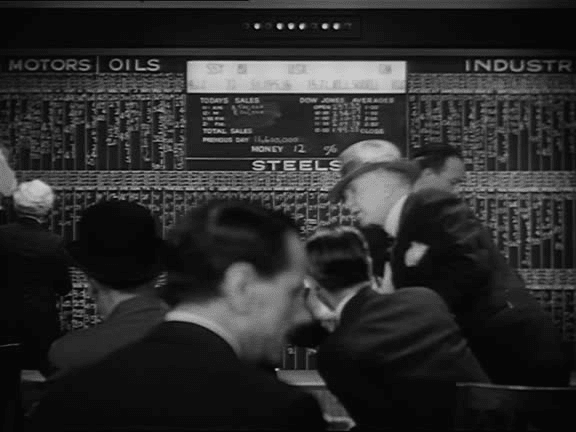
2/
Understanding rolling over through case studies
Bitcoin 2020-2021 bull market review. From October 2020 to March 2021, Bitcoin rose from $10,000 to $60,000. We take this period as an example to review how rolling over operations can help funds grow rapidly.
This is a one-sided upward trend in a bull market. We will review the rolling over operations during this period, focusing on how to effectively roll over to achieve rapid compound growth of capital.
First entry (Figure 1)
At the K-line at the position of the arrow in the image below, we can see that after a period of medium to long-term fluctuations, Bitcoin formed a converging triangular structure. At this position, a large bullish line broke above the descending trend line, sending us a bullish signal.
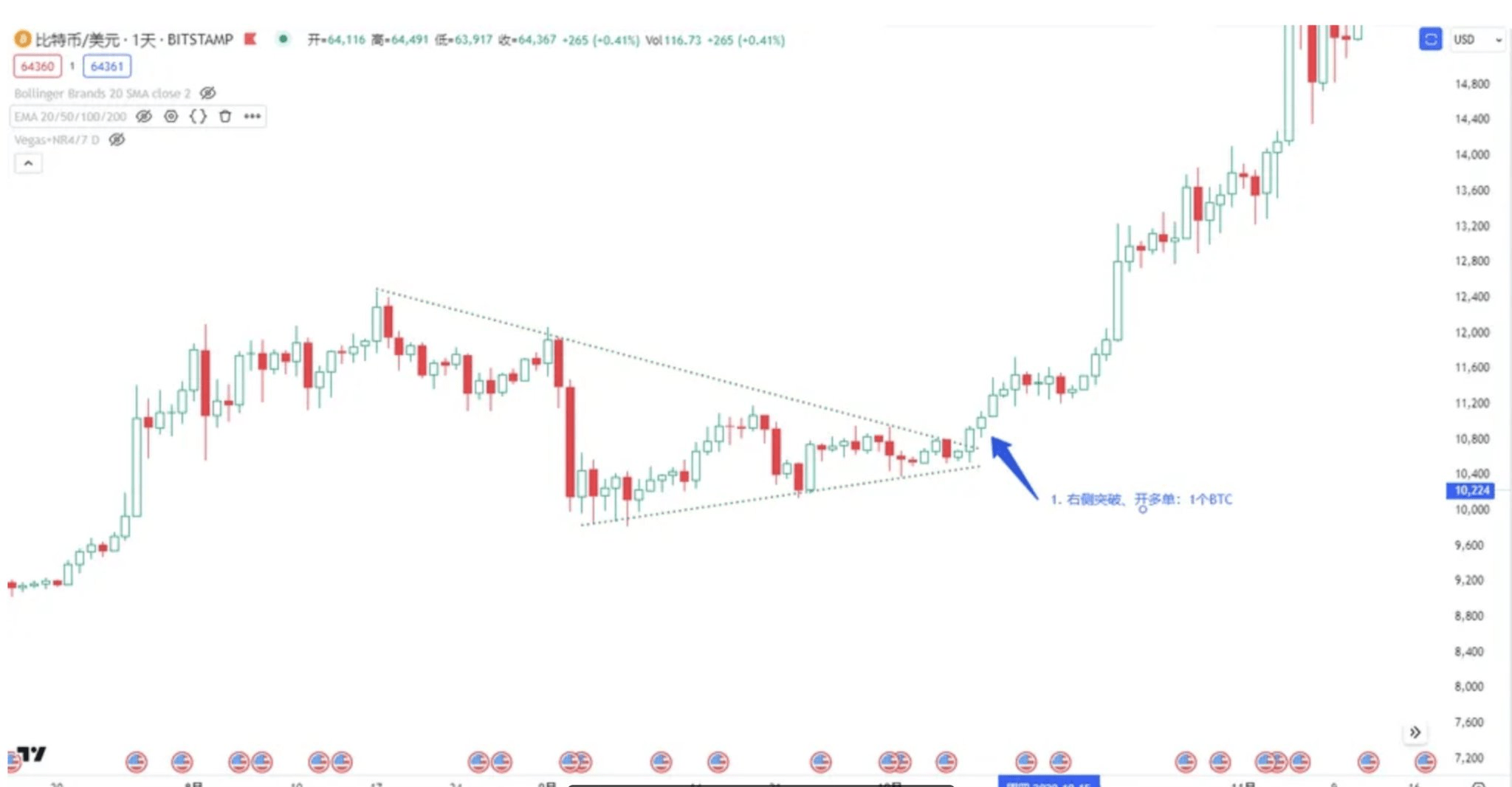
Convergence triangle right side big bullish line breaks, sending out a bullish signal
Therefore, at this position indicated by the arrow, when BTC issued a bullish signal on the right side, we can track the right side breakout here, assuming we opened a long position in BTC at this time
Second entry (Figure 2)
The following market entered a very strong upward trend. At the position pointed to by the mouse, we can see that Bitcoin has formed a converging triangular shape.
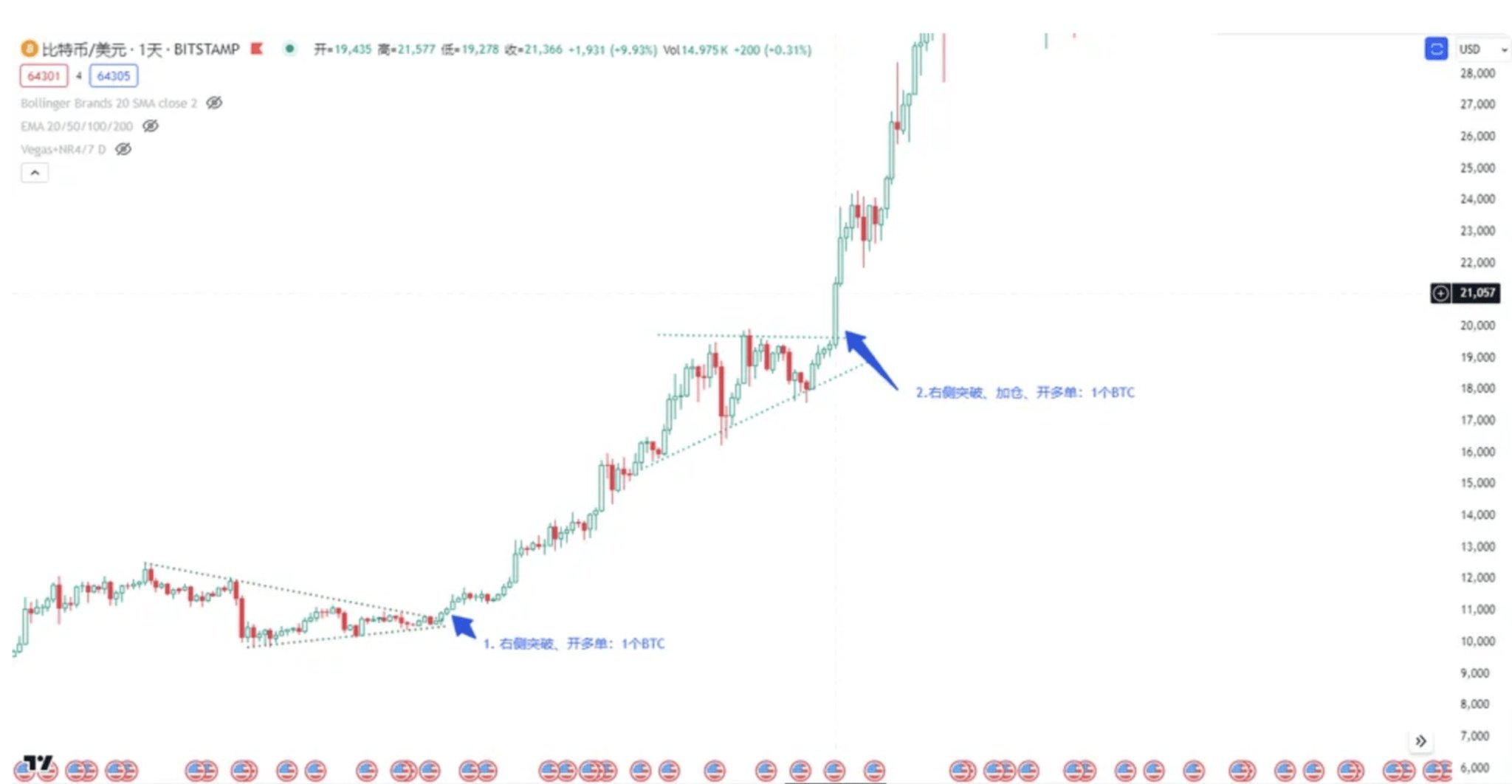
(Figure 3) At this position, it is precisely the right timing defined by the 'fat man', which is the time to roll over, located at the place pointed to by arrow 2. If we pursue the right side breakout at this position and open a long position in BTC, we can see that after several medium to long-term fluctuations, Bitcoin broke through its previous high with a large bullish line. This position aligns with the three axes of the 'fat man' trading: right side trading, pursuing breakouts, and increasing positions with floating profits.
Additionally, at the position where the converging triangle formed at arrow 2, there is also a position to increase the position, which is indicated by arrow 3.
We can consider it as a support point for the upward trend line. At this position, according to the strategy defined by the 'fat man', increasing the position during a pullback is feasible. When the price drops near the upward trend line and forms a small real body candlestick, a large bullish line appears, which is also an opportunity to increase the position and a process of rolling over.
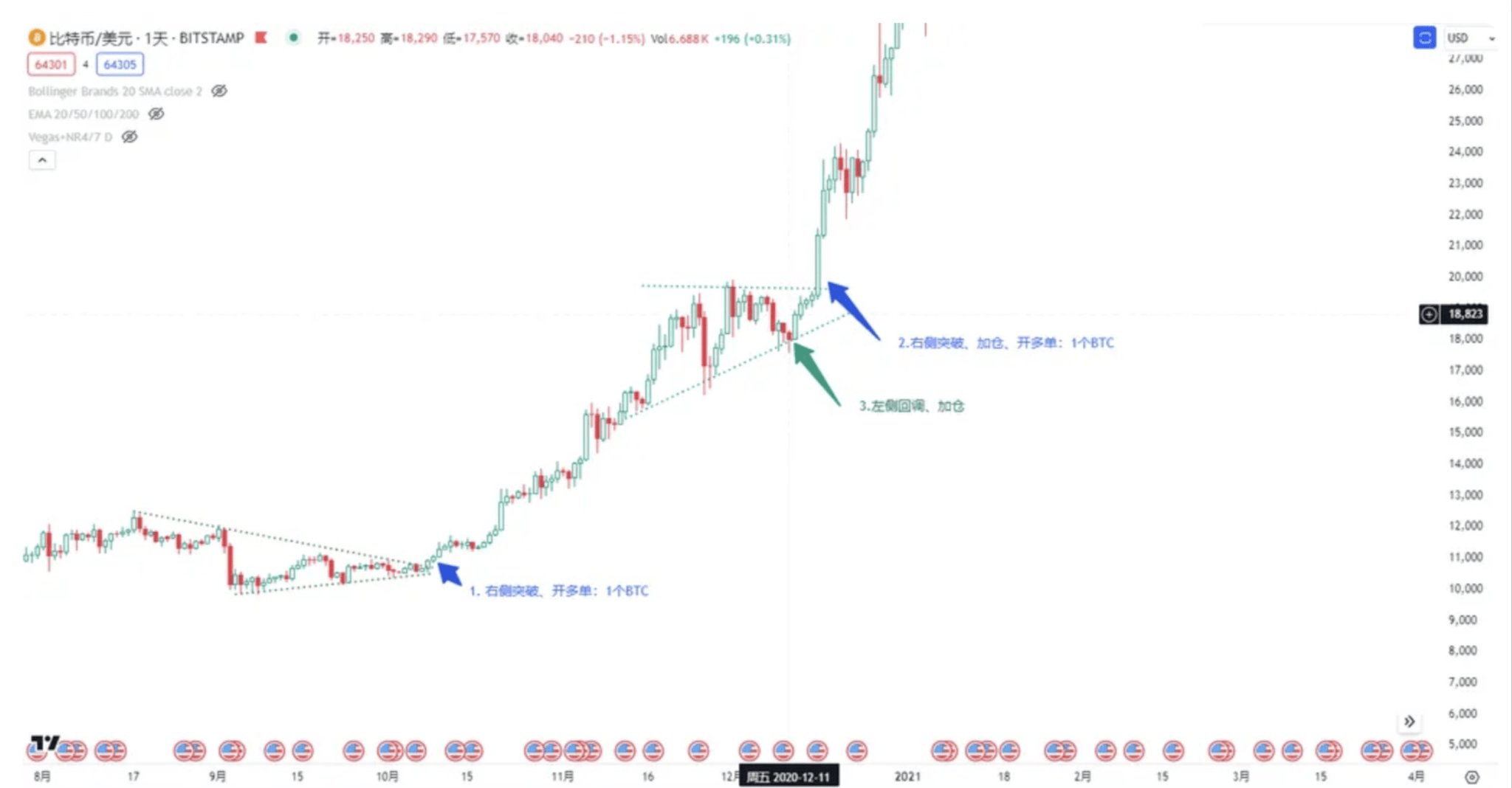
(Figure 4) It is important to note that the position of arrow 3 belongs to relatively left-side trading. Left-side trading carries higher risks, but the risk-reward ratio for entry is better. Compared to the first position, the second position is a floating profit increase (also known as rolling over). It can be seen that the following market experienced a strong upward trend, and by January 2021, the price of Bitcoin reached about $40,000, then experienced a significant pullback and formed another converging triangular structure.
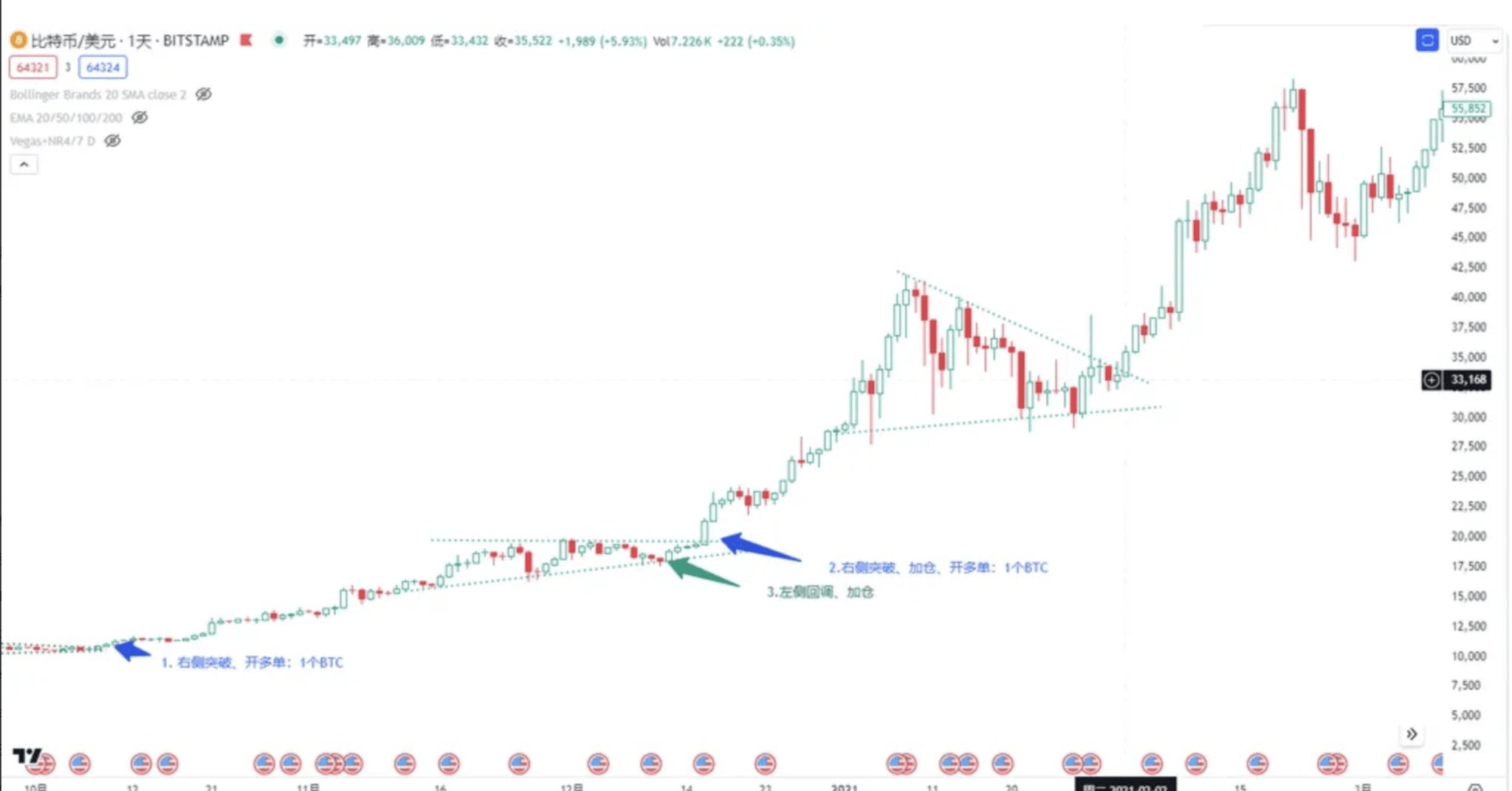
Third opportunity to increase the position
Looking back from the price of 40518, we will find that there are also opportunities for rolling over. As shown in the figure, point 4 is a position for pursuing a right-side breakout, suitable for rolling over. Similarly, point 5 is a position for increasing the position on the left side during a pullback (similar to the previous point 3, left-side position increases have a better risk-reward ratio).
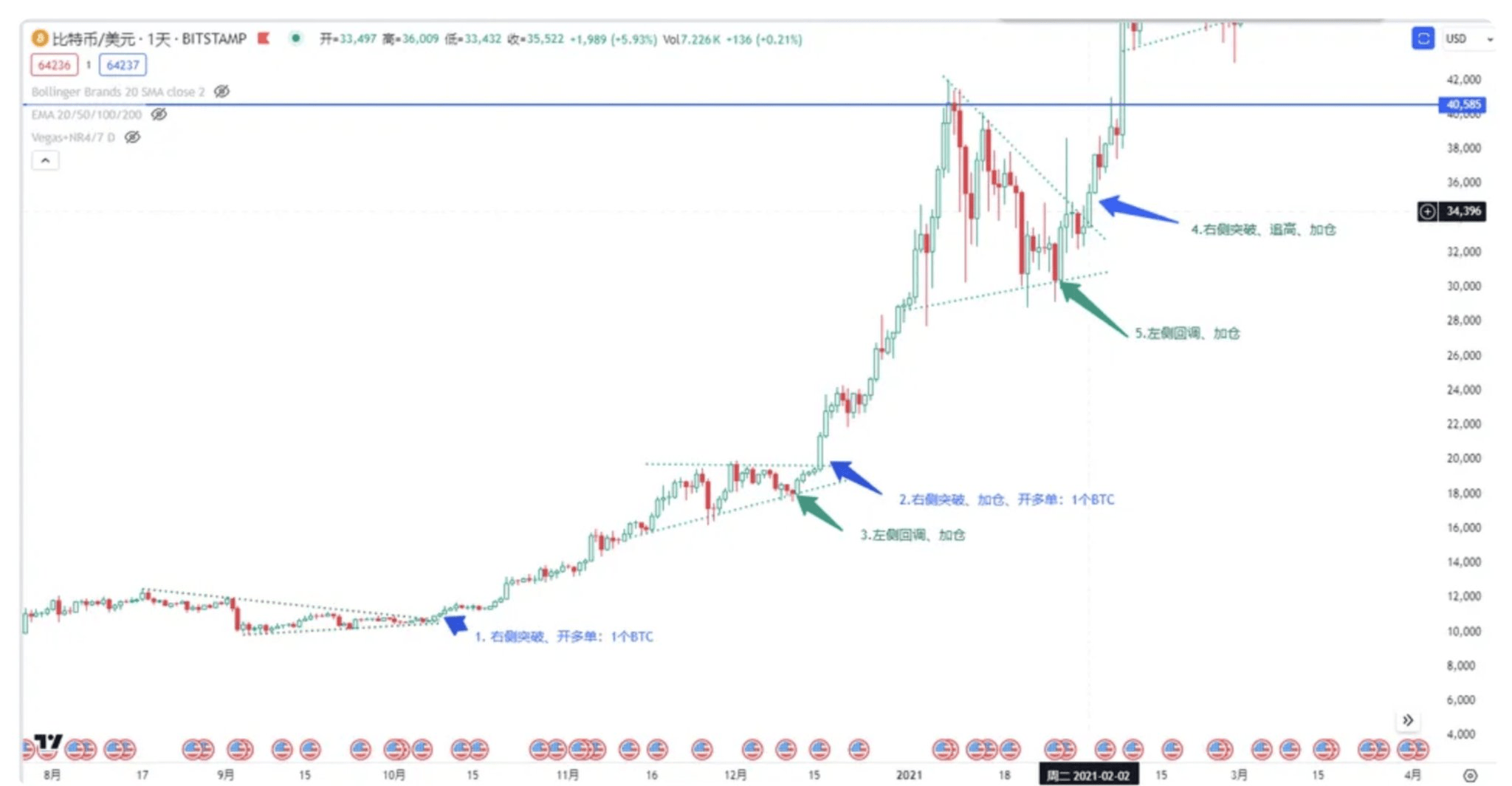
3/
Core strategy of rolling over
Applicable conditions: one-sided market
The core applicable condition for the rolling over strategy is a one-sided market, which means a clear trend market. In a fluctuating market, the rolling over strategy may lead to frequent stop losses or even losses. Therefore, you must wait for clear trend signals from the market, such as breakouts after long periods of sideways movement, before it is suitable for rolling over operations.
Mindset and timing
Rolling over not only tests your technical analysis ability but also tests your mindset. When faced with opportunities with enormous profit potential, you must have enough patience to wait for high-certainty moments. Rolling over is not suitable for frequent operations. We only increase positions in confirmed trend opportunities, such as breakouts after long-term resistance levels or one-sided markets after fluctuating patterns.
Core logic: position management and trend judgment
The core of rolling over lies in position management and trend judgment. In judging the trend, you need to distinguish between true and false breakouts, and identify when there is a pullback and when there is a trend reversal. This not only requires technical analysis skills but also strict capital management and trailing stop-loss strategies. After each position increase, move the stop-loss level up to ensure that the floating profit part is not swallowed by market fluctuations.
Timing and ratio for increasing positions
The timing for increasing positions in rolling over is crucial. Usually, increase positions in line with the trend after breaking through the trend line, or counter the trend when the trend pulls back to near the moving average. The funds for each increase should be pyramid-shaped, with the proportion of subsequent increases gradually decreasing to avoid excessive risk from later increases.
Practical steps
Step 1: Initial entry
Establish a position at a breakout point after sufficient fluctuations, such as breaking through important resistance levels. Control the initial position at 10%-20% of the total capital to avoid significant market fluctuations. At this time, set the stop-loss level usually 2%-3% below the critical support level.
Step 2: Trend-following position increase
When the initial position shows a floating profit, you can choose to increase your position during the next pullback or breakout point. Usually, when the price pulls back near the moving average and rebounds, or breaks through before and after, it can serve as a signal to increase the position. The proportion of funds for each increase should not be too large; it is generally recommended that the increase does not exceed 30% of the original position.
Step 3: Risk control and profit-taking strategy
The risk control of the rolling over strategy is particularly important. With each position increase, you need to use a trailing stop-loss, gradually moving the stop-loss level to the previous position increase point to ensure that the floating profit part is not swallowed by market fluctuations. When reversal signals occur, promptly reduce or close positions to avoid significant drawdowns.
Step 4: Accumulate compound interest
After each successful rolling over, you can continue to invest the floating profit part into increasing positions, forming compound growth. However, avoid frequent operations; rolling over is suitable for medium to long-term trends, not short-term frequent increases. The goal of rolling over is to continuously expand positions with the continuation of the trend, maximizing profits.
Trading frequency
Rolling over operations are suitable for conducting when breaking through significant resistance and support levels on daily or weekly charts, not for frequent short-term trading. Frequent position increases in a fluctuating market carry extreme risks, which may lead to significant losses.
Although the rolling over strategy can amplify profits, the essence of increasing positions with floating profits is to increase leverage and risk. Therefore, it is recommended to use a pyramid mode when increasing positions, with less increase as you progress. When the profits are substantial, consider gradually reducing positions rather than continuously increasing them.
Capital and stop-loss management
In the rolling over strategy, scientific capital management and trailing stop-loss strategies are key. If the stop-loss level is not adjusted in time after increasing positions, it may turn the original floating profit into a loss. Before each position increase, be sure to set the specific position and trailing stop-loss strategy in advance.
These are some basic concepts of rolling over.
I am Sky, a senior trader, empowering excellent project parties with traffic.